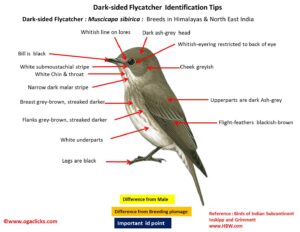
Dark-sided Flycatcher Muscicapa sibirica
Etymology:
- Muscicapa : Latin Word musca – fly; capere – to catch
- Sibirica: From Siberia.
Distribution in India: Breeds in Himalayas and North East India.
Description: Size of 13-14 cm. It is a small to medium-sized, slim grey-and-white flycatcher with long wings ,tips of primaries extend about two-thirds down closed tail on nominate race, large dark eye, and small, broad-based bill. Nominate race has dark ash-grey head and upperparts, conspicuous white eyering often restricted to or most prominent at rear of eye, narrow buffish lores , fairly broad whitish submoustachial stripe, grey malar stripe; upperwing and tail blackish. In fresh plumage greater upperwing-coverts with pale buff tips forming wingbar and tertials and inner secondaries with pale buffish-white edges, rest of flight-feathers edged plain brown; chin and throat whitish, white usually extending on side of neck to form half-collar; upper breast and flanks grey-brown, streaked darker, rest of underparts white, undertail-coverts with small greyish tips; iris dark brown; bill and legs black. Both the sexes are alike.
Habit: It is found during breeding in montane and submontane evergreen forests and woods, including rhododendron, coniferous and mixed coniferous-deciduous secondary forests. On migration occurs in coastal scrub, plantations, parks and large gardens; in winter in similar habitat of lowland mature and secondary forests, and more frequently in canopy of trees
Food Habits: It eats small invertebrates, like flies and beetles .Usually found in pairs, or solitary when not breeding. Forages in forest glades and clearings, including along roads and paths. Often most active in late afternoon and at dusk. Sits alert and upright on high, open or prominent perch; pursues insects in flight, frequently returning to same perch; after rainfall, also forages low down or close to ground.
Breeding Habits: They breed in May-Aug in India. The nest is built by female. The nest is a neat and compact cup of moss, lichens, fine grasses, animal hair, small feathers and gossamer, well camouflaged on horizontal branch, behind loose bark, or in old stump or in hole in tree. It lays a clutch of 3–4 eggs. The incubation is done by female and incubating female fed by male.